
Amira Benhima
A passionate advocate for holistic wellness and natural beauty, is an accomplished author specializing in the benefits and uses of Argan oil, with years of experience exploring its wonders.
Key Takeaways
Have you ever wondered why the argan oil harvest by Berber women in Morocco is considered so remarkable? The truth behind this theory lies in the unique cultural and economic significance it holds. The process of harvesting and producing argan oil involves labor-intensive tasks that have been passed down through generations. From the drying and grinding of argan fruits to the extraction of the precious oil, these women play a vital role in preserving this cherished Moroccan tradition. But what makes their work truly fascinating is the empowerment and community development that stems from their efforts. Stay tuned to discover more about the role of Berber women in the argan oil industry and the benefits it brings to both their livelihoods and the preservation of their rich culture.
- Berber women play a crucial role in the traditional and labor-intensive process of argan oil production.
- Their participation in local cooperatives empowers them economically and fosters sustainability.
- Sustainable production methods and community empowerment are prioritized in argan oil production.
- Argan oil benefits both health and beauty and contributes to environmental conservation.
Traditional Practices
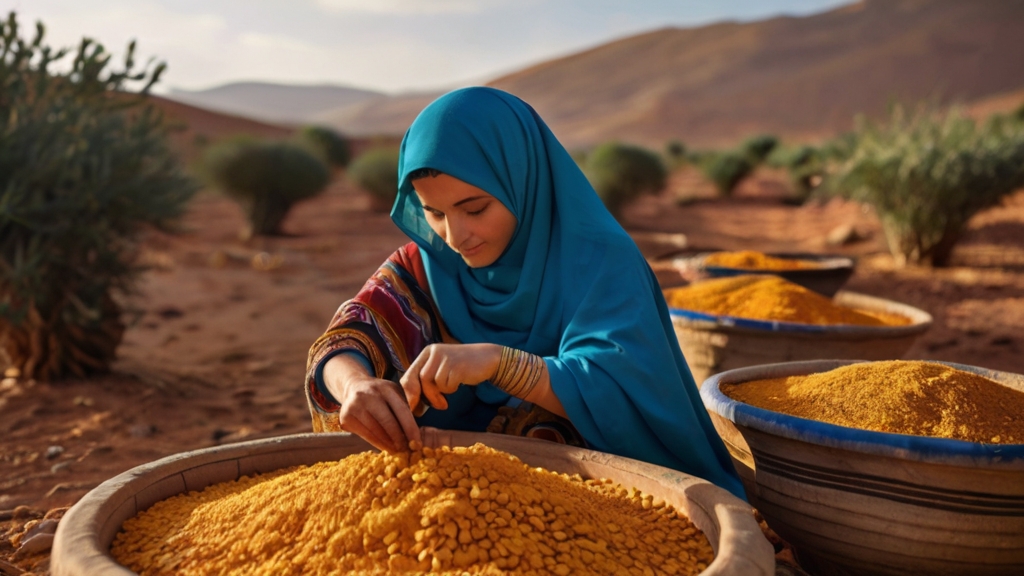
Berber women in Morocco have upheld a rich tradition of harvesting argan fruit by hand, passing down their ancestral knowledge from generation to generation. This traditional practice showcases their deep connection to the land and their cultural heritage.
The process of harvesting argan fruit is not an easy task. It begins with cracking the argan fruit nuts to extract the kernels inside. This labor-intensive task requires skill and precision, as the women carefully crack the nuts without damaging the kernels. Once the kernels are extracted, they are ground into a paste using traditional grinding stones. This process can take several days of manual labor to produce just a liter of argan oil.
Despite the arduous nature of the work, Berber women approach the task with a sense of joy and community. They often come together in communal gatherings to help each other out in the process. These gatherings are filled with laughter, songs, and stories, making the labor-intensive process more enjoyable. Through these gatherings, the women not only support one another but also strengthen their bonds and preserve their cultural traditions.
The traditional practices of argan oil harvest by Berber women serve as a testament to their resilience and resourcefulness. They have developed a deep understanding of the land and its resources, utilizing them in a sustainable and respectful manner. By upholding this tradition, Berber women not only provide for their families and communities but also preserve their cultural identity. Their commitment to hand-harvesting argan fruit showcases their dedication to their heritage and their role as guardians of the land.
Role of Berber Women
Playing a central role in the production of argan oil, the Berber women of Morocco contribute to their empowerment and economic independence through their labor-intensive work. Here is a closer look at the role of Berber women in argan oil production:
- Local cooperatives: Berber women are part of local cooperatives where they engage in the labor-intensive process of extracting oil from argan nuts. These cooperatives provide a platform for women to come together, work collaboratively, and support each other.
- Preserving tradition: Through their work, Berber women are preserving a centuries-old tradition of argan oil production. They are passing down valuable skills and knowledge to future generations, ensuring the continuation of this cultural practice.
- Empowerment and sustainability: By participating in argan oil production, Berber women not only contribute to the global demand for this valuable product but also promote sustainable practices. The extraction process involves manual labor and does not involve any chemicals or industrial processes, making it environmentally friendly.
The role of Berber women in argan oil production goes beyond just economic benefits. It allows them to have a sense of empowerment and independence, as they are actively involved in the entire production process. Through their labor-intensive work, they are able to support their families and communities while preserving their cultural heritage. The cooperative model further enhances their social and financial opportunities, allowing them to thrive and make a positive impact. Berber women are truly the backbone of argan oil production, and their contribution is invaluable.
Harvesting the Argan Fruit
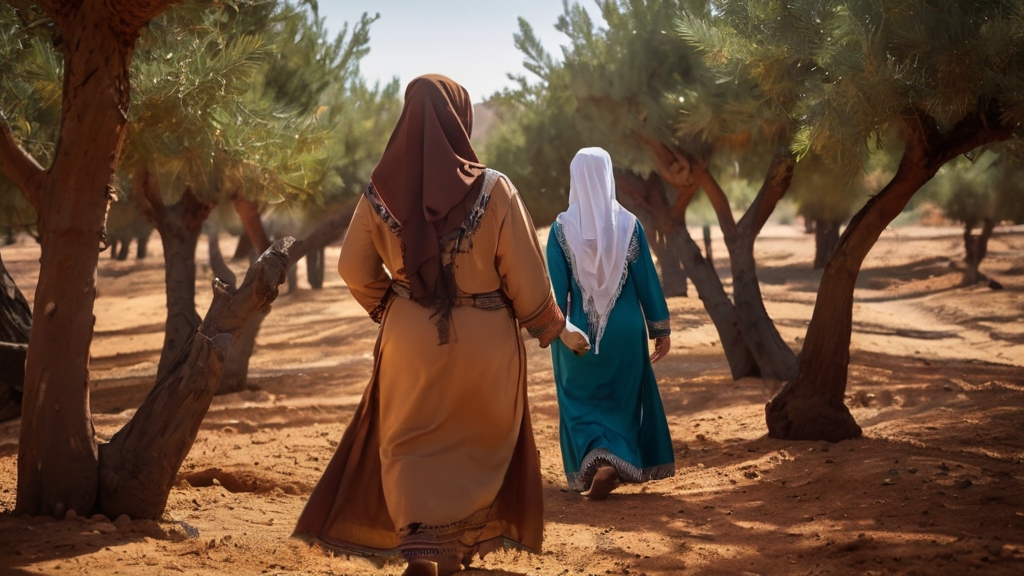
During the harvest season in Southern Morocco, skilled hands delicately pluck the ripe argan fruit from the branches, beginning the process of extracting the valuable kernels within. The harvest season typically runs from June to August each year, a time when the argan trees are heavy with the precious fruit. Berber women, known for their expertise in the art of argan oil production, play a vital role in this labor-intensive task.
To paint a picture of the harvest process, imagine a scene under the scorching Moroccan sun. Rows of argan trees stretch as far as the eye can see, their branches adorned with clusters of small, oval-shaped argan fruit. Berber women, dressed in vibrant traditional attire, gather beneath the trees, their nimble fingers swiftly and skillfully plucking the ripe argan fruit. They work with precision, selecting only the fruit that has reached its peak ripeness, ensuring the highest quality oil.
To better understand the process, let’s take a closer look at the steps involved in harvesting the argan fruit:
| Step | Description |
|---|---|
| 1 | Delicately plucking ripe argan fruit |
| 2 | Collecting the fruit in woven baskets |
| 3 | Removing the pulp from the fruit |
| 4 | Drying the kernels in the sun |
| 5 | Cracking open the dried kernels |
The skill and patience required to complete these steps are a testament to the dedication of the Berber women. Each harvested argan fruit brings them one step closer to the precious kernels that will ultimately yield the highly sought-after argan oil.
As the Berber women continue to harvest the argan fruit, their commitment to preserving this ancient tradition shines through. Their expertise in delicately handling the fruit ensures that every drop of argan oil produced is of the highest quality, ready to nourish and serve those who seek its remarkable benefits.
Extracting the Precious Oil
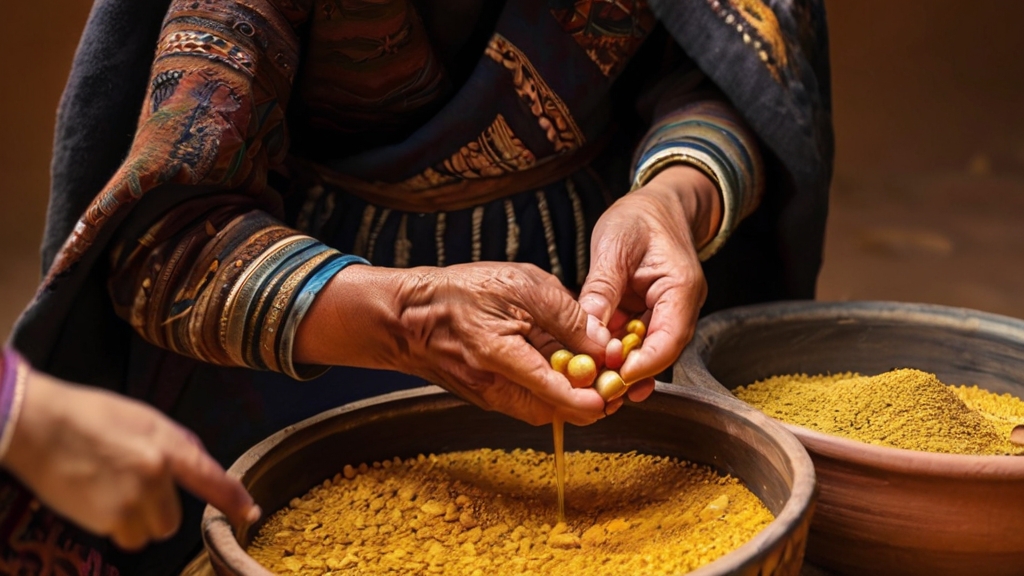
As you watch the Berber women in Southern Morocco extract argan oil, you can see the traditional techniques they employ. With nimble hands, they crack open the hard shells of the argan nuts, revealing the precious kernels within. It is a labor-intensive process that requires patience and precision, but their expertise ensures the production of high-quality oil.
Traditional Extraction Techniques
The traditional extraction techniques used by Berber women to obtain the precious argan oil involve a labor-intensive process of drying, peeling, and grinding the argan fruit. Here is a closer look at the steps involved in this ancient method:
- Drying: Berber women carefully lay out the argan fruit in the sun, allowing it to dry naturally. This step helps to separate the fruit from its outer pulp, making it easier to extract the oil.
- Peeling: Once dried, the Berber women skillfully remove the outer pulp to reveal the hard argan nut inside. This nut contains the precious kernels that will be used to make the oil.
- Grinding: Argan kernels are then meticulously ground using a stone grinder. This process can take up to three days to produce just one liter of oil. The resulting paste is then pressed to extract the golden argan oil.
These traditional extraction techniques not only yield high-quality argan oil but also showcase the rich cultural heritage of the Berber women who have passed down these methods for generations.
Women’s Role in Harvesting
To witness the intricate process of harvesting argan oil, one must observe the skilled hands of Berber women as they crack the nuts and extract the precious oil with utmost precision and care. These women play a crucial role in the extraction process, using their expertise to carefully remove the hard kernel shells and access the valuable argan oil within. At local cooperatives, these dedicated women spend hours grinding the argan kernels, with each liter of oil requiring up to three days of their diligent work. It is a labor-intensive process that combines traditional techniques with modern machines, highlighting the manual labor involved. Despite the challenges, these women find joy and camaraderie in working together to produce the highly sought-after argan oil.
Sustainable Production Methods
Berber women’s skilled hands meticulously crack argan nuts, extracting the precious oil with utmost precision and care. The sustainable production methods they employ ensure the long-term health of the argan tree and the environment. Here’s how they do it:
- Hand Extraction: Berber women rely on their dexterous fingers to crack open the argan nuts, revealing the valuable kernels inside. This manual process not only preserves the quality and nutrients of the oil but also contributes to the authenticity and cultural significance of argan production.
- Labor-Intensive Process: The hand extraction method is labor-intensive, requiring patience and expertise. Berber women carefully crack each nut, separating the kernels from the shells. This meticulous approach guarantees the highest quality oil and ensures that no part of the nut goes to waste.
- Traditional Grinding: After extracting the kernels, Berber women use traditional grinding methods to crush them into a paste. This paste is then pressed to extract the argan oil. By sticking to these age-old techniques, the women maintain the integrity of the oil and honor their cultural heritage.
The sustainable production methods employed by Berber women not only yield exceptional argan oil but also preserve the rich cultural traditions associated with its production.
Community Empowerment
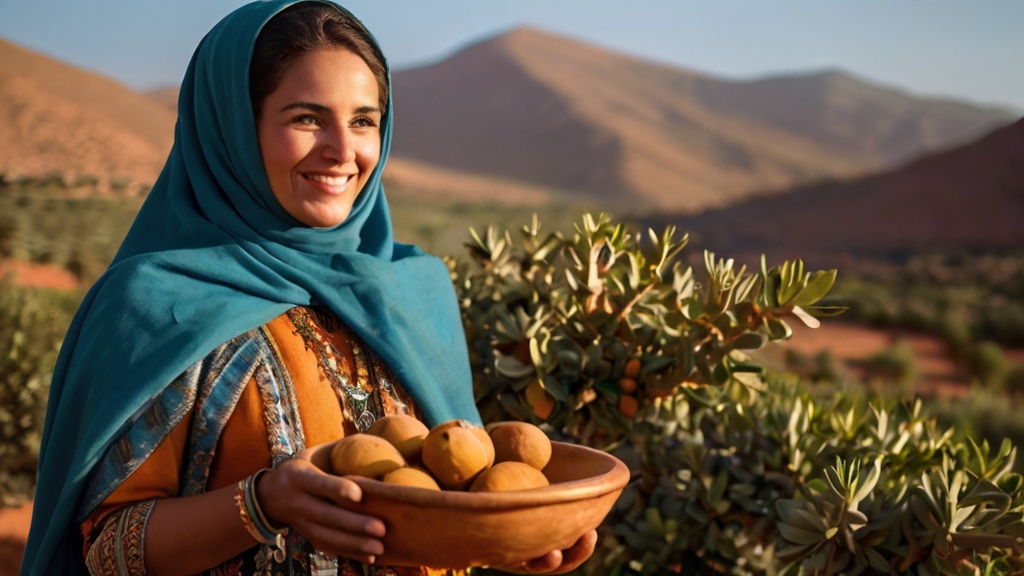
You observe a tight-knit community of Berber women in rural Morocco who have found empowerment through the production of argan oil. They have created a sustainable income opportunity for themselves by working in cooperatives, allowing them to support their families and contribute to their community’s well-being. These women also have access to skills development programs, which further enhance their professional growth and economic independence.
Women’s Economic Empowerment
Argan oil cooperatives in Morocco have become a powerful force in women’s economic empowerment, providing employment, benefits, and a sense of community for rural Berber women. Here are three key ways in which these cooperatives are making a difference:
- Employment opportunities: By working in argan oil cooperatives, women are able to earn a livelihood and support themselves and their families. This economic independence allows them to improve their living conditions and break the cycle of poverty.
- Benefits and support: Women working in cooperatives receive various benefits, including salaries, childcare services, health insurance, and access to literacy courses. These benefits not only enhance their financial stability but also contribute to their personal and professional growth.
- Community empowerment: The cooperative model fosters a sense of community among the women involved in argan oil production. Through mutual support and collaboration, they are able to uplift each other, share knowledge, and collectively work towards economic empowerment.
Argan oil cooperatives play a crucial role in empowering women by providing them with employment opportunities, benefits, and a strong sense of community. These initiatives not only improve the lives of rural Berber women but also contribute to the overall development of their communities.
Skills Development Programs
Skills development programs in the argan oil industry have become a catalyst for community empowerment, offering Berber women in Morocco the opportunity to enhance their expertise in oil extraction techniques and contribute to sustainable production practices. These programs aim to improve the efficiency and quality of argan oil production while nurturing personal and professional growth among the women. Through a combination of traditional and modern techniques, the women acquire valuable skills in every aspect of argan oil production, from harvesting to packaging. This comprehensive training equips them with the knowledge and confidence to ensure sustainable practices and economic empowerment. The skills development programs also foster community support and collaboration, strengthening the role of Berber women in the argan oil industry. By investing in their skills, the programs empower these women to become key contributors to the production and success of argan oil in Morocco.
| Skills Development Programs in the Argan Oil Industry | ||
|---|---|---|
| Empowerment | Enhanced Expertise | Sustainable Practices |
| Community support and collaboration | Valuable expertise in oil extraction techniques | Training in traditional and modern methods |
| Personal and professional growth | Confidence in the entire production process | Economic empowerment |
| Key contributors to the production of argan oil | Nurturing skills in harvesting, extraction, and packaging | Ensuring sustainable production practices |
Keywords: argan oil production.
Sustainable Income Opportunities
Berber women in Morocco’s argan oil cooperatives are experiencing a transformation in their lives as they embrace sustainable income opportunities. Through the production of argan oil, these women are not only able to earn a living but also enjoy a range of benefits that contribute to their overall well-being. Here are three ways in which sustainable income opportunities in argan oil production are empowering these women and their communities:
- Financial stability: The income generated from argan oil production provides these women with a stable source of income, allowing them to support themselves and their families.
- Social support: Working in cooperatives fosters a sense of community and support among the women. They have the opportunity to share knowledge and experiences, empowering each other in their journey towards economic independence.
- Quality of life improvement: With the income earned, these women can access better healthcare, education, and other essential services, improving their overall quality of life.
Health and Beauty Benefits
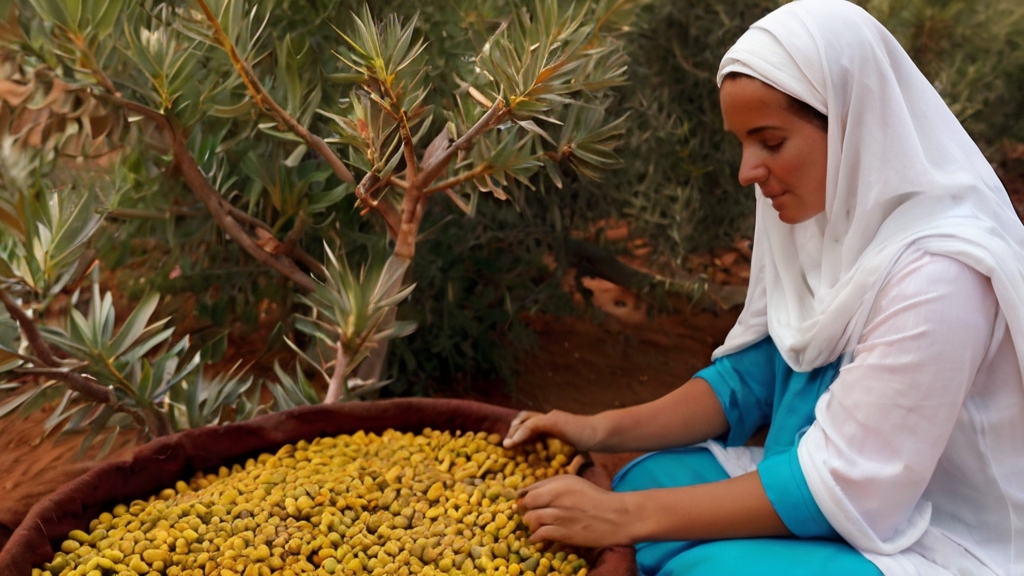
Regular use of this remarkable oil can enhance the health and beauty of your skin and hair. Argan oil, derived from the kernels of the argan tree, is a powerhouse of nutrients that can transform your beauty routine. Its high content of vitamin E, essential fatty acids, and antioxidants make it ideal for nourishing and protecting your skin and hair.
For your skin, argan oil offers numerous benefits. Its anti-inflammatory properties help reduce redness, irritation, and inflammation, making it effective in treating conditions such as acne, eczema, and psoriasis. Additionally, the oil’s healing properties promote skin repair and rejuvenation, leaving your complexion smooth and radiant. Argan oil is also known to improve skin elasticity and reduce the appearance of wrinkles, giving you a more youthful and vibrant look. Whether you have dry, oily, or combination skin, the balanced composition of oleic and linoleic acids in argan oil helps regulate oil production, preventing clogged pores and promoting a clear, healthy complexion.
When it comes to your hair, argan oil works wonders. Its moisturizing properties deeply hydrate dry and damaged hair, restoring its softness and shine. The oil’s nourishing ingredients penetrate the hair shaft, strengthening and repairing it from within. Regular use of argan oil can also help prevent split ends and breakage, promoting healthier and more manageable locks.
Sustainable Production Methods
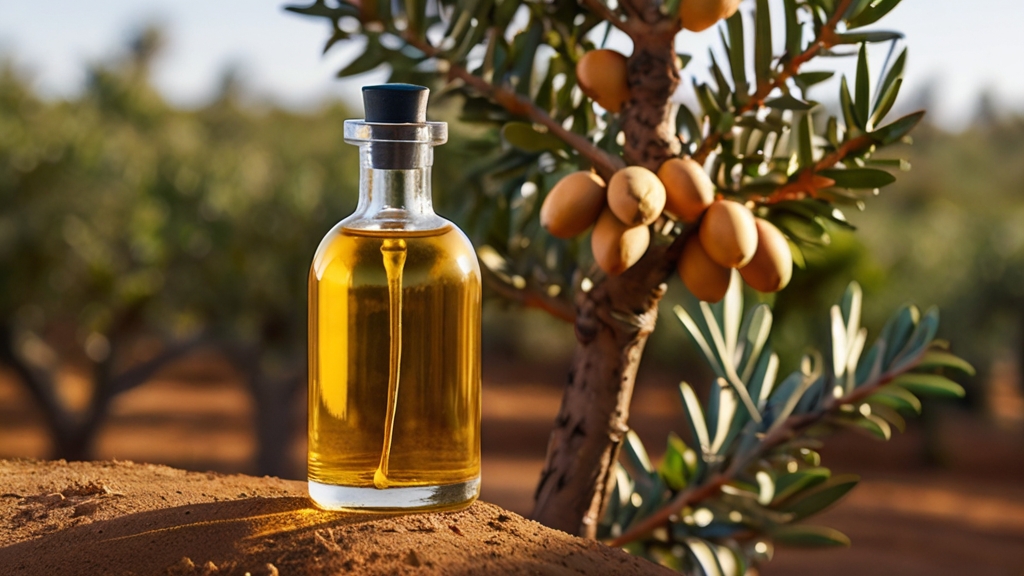
Sustainable production methods in the harvesting of argan oil involve the skilled manual labor of Berber women, who play a vital role in preserving the ecosystem of the argan tree. Here are three key aspects of these sustainable production methods:
- Manual Labor: The process of extracting argan oil starts with cracking the nuts and extracting the kernels. This labor-intensive task requires precision and expertise, which the Berber women have mastered over generations. Their careful handling ensures that only the kernels are extracted, leaving the shells intact for other uses.
- Emphasis on Sustainability: Local cooperatives in Morocco have recognized the importance of preserving the argan tree ecosystem. They prioritize sustainable practices that promote the well-being of both the trees and the environment. This includes avoiding the use of harmful chemicals and pesticides and promoting organic cultivation methods.
- Traditional Techniques with Modern Machinery: While the manual labor remains an integral part of argan oil production, modern machinery is also being utilized to enhance efficiency without compromising sustainability. This combination of traditional techniques and modern equipment ensures that the production process is streamlined while maintaining the integrity of the ecosystem.
Preserving Berber Culture
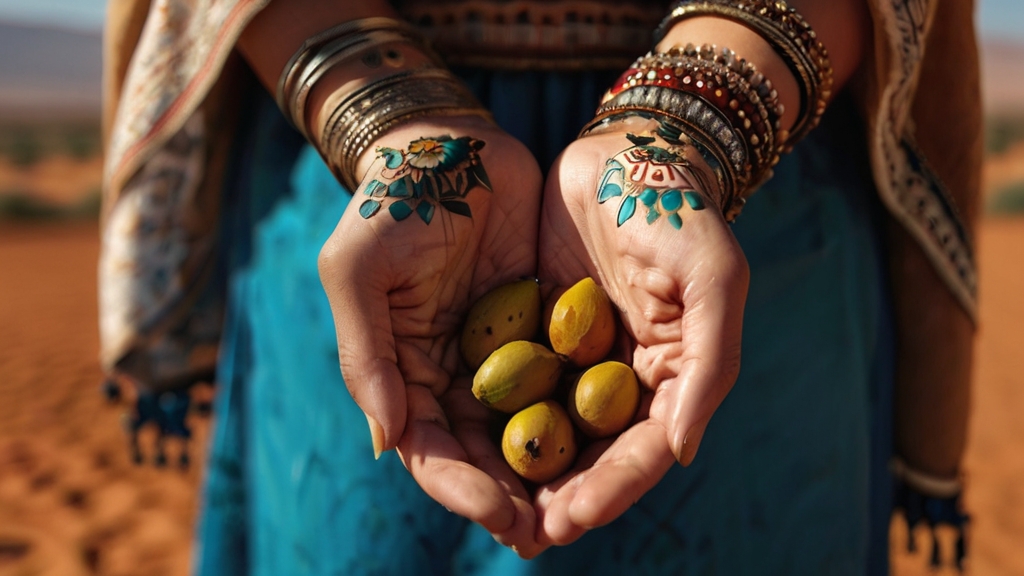
Preserving the cultural heritage of the Amazigh community, the tradition of argan oil production has been faithfully upheld by Berber women for centuries. The cooperative work of these women in producing argan oil not only showcases their rich cultural heritage but also promotes women’s empowerment and community support.
Argan oil production serves as a symbol of tradition and heritage for Berber women, reflecting the deep-rooted significance of the practice in Moroccan culture. The meticulous process of extracting oil from the argan tree’s kernels requires skill and expertise that has been passed down through generations. The women carefully crack the argan nuts by hand, extract the kernels, and then grind them to create a paste. This paste is then pressed to extract the precious oil. This intricate process is not only a testament to their cultural practices but also highlights their dedication to preserving their traditions.
Working together in cooperatives to produce argan oil fosters camaraderie among Berber women, highlighting the communal aspect of their cultural practices. These cooperatives provide a space for the women to exchange knowledge, techniques, and stories, further strengthening their bonds and sense of unity. Through their dedication to argan oil production, Berber women contribute to the sustainability and preservation of their cultural identity and traditions.
Frequently Asked Questions
Why Is Moroccan Argan Oil so Expensive?
You might be wondering why Moroccan argan oil is so expensive. Well, let me tell you, it’s like capturing liquid gold. The labor-intensive process of harvesting the argan nuts by Berber women is one reason for its high price. The limited growing region and international demand also play a role. But here’s the thing, this precious oil is not just about luxury, it’s about sustainability. The careful and time-consuming extraction process ensures the highest quality and purity, making it worth every penny.
What Is the Difference Between Argan Oil and Moroccan Argan Oil?
The difference between argan oil and Moroccan argan oil lies in the origin and production process. Argan oil can come from different regions, while Moroccan argan oil specifically refers to oil produced in Morocco. Moroccan argan oil is highly valued for its traditional production methods, often carried out by Berber women in cooperatives. These women play a crucial role in the argan oil production, using their expertise and craftsmanship to harvest and extract the oil. This adds a cultural and community aspect to the production of Moroccan argan oil.
Is Argan Oil Good for African American Skin?
Yes, argan oil is good for your African American skin. It has amazing skin benefits that can help moisturize, nourish, and improve the elasticity of your skin. It can also reduce inflammation and address concerns like dryness, eczema, and hyperpigmentation. Argan oil is non-comedogenic, making it suitable for all skin types, including acne-prone skin. It also protects against sun damage and oxidative stress, giving you a healthy and radiant complexion. Regular use will give you smoother and more even-toned skin.
How Much Is a Bottle of Argan Oil in Morocco?
In African markets, a bottle of argan oil in Morocco can cost anywhere from $30 to $250 per liter. It’s fascinating how the price reflects not only the quality of the oil but also the labor-intensive process involved in its production. Moroccan women, particularly those working in cooperatives, play a significant role in this industry, benefiting from perks like salary, childcare, health insurance, and literacy courses. Their dedication and expertise contribute to the high value of argan oil in the local market.
Related Articles
Argan Oil Production From Argania Spinosa
Kept under lock and key, the secrets of argan oil production from Argania spinosa reveal the hidden treasures of this legendary liquid gold.
Harvesting Argan for Organic Oil Production
Ponder the remarkable benefits and sustainable practices involved in harvesting argan for organic oil production, and discover the intriguing role of women and unique extraction methods.
Health Benefits of Pure Argan Oil
Jumpstart your health and discover the surprising benefits of pure argan oil, from glowing skin to potential cancer-fighting properties.


